The Intel Ivy Bridge (Core i7 3770K) Review
by Anand Lal Shimpi & Ryan Smith on April 23, 2012 12:03 PM EST- Posted in
- CPUs
- Intel
- Ivy Bridge
Quick Sync Image Quality & Performance
Intel obviously focused on increasing GPU performance with Ivy Bridge, but a side effect of that increased GPU performance is more compute available for Quick Sync. As you may recall, Sandy Bridge's secret weapon was an on-die hardware video transcode engine (Quick Sync), designed to keep Intel's CPUs competitive when faced with the onslaught of GPU computing applications. At the time, video transcode seemed to be the most likely candidate for significant GPU acceleration so the move made sense. Plus it doesn't hurt that video transcoding is an extremely popular activity to do with one's PC these days.
The power of Quick Sync was how it leveraged fixed function decode (and some encode) hardware with the on-die GPU's EU array. The combination of the two resulted in some pretty incredible performance gains not only over traditional software based transcoding, but also over the fastest GPU based solutions as well.
Intel put to rest any concerns about image quality when Quick Sync launched, and thankfully the situation hasn't changed today with Ivy Bridge. In fact, you get a bit more flexibility than you had a year ago.
Intel's latest drivers now allow for a selectable tradeoff between image quality and performance when transcoding using Quick Sync. The option is exposed in Media Espresso and ultimately corresponds to an increase in average bitrate. To test image quality and performance, I took the last Harry Potter Blu-ray, stripped it of its DRM and used Media Espresso to make it playable on an iPad 2 (1024 x 768 preset).
In the case of our Harry Potter transcode, selecting the Better Quality option increased average bitrate from to 3.86Mbps to 5.83Mbps. The resulting file size for the entire movie increased from 3.78GB to 5.71GB. Both options produced a good quality transcode, picking one over the other really depends on how much time (and space) you have as well as the screen size of the device you'll be watching it on. For most phone/tablet use I'd say the faster performing option is ideal.
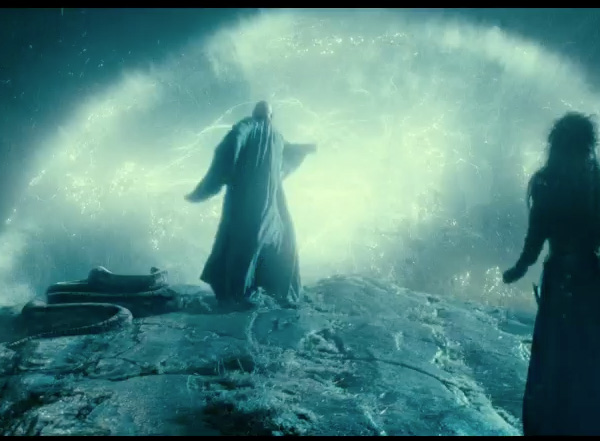
| Intel Core i7 3770K (x86) | Intel Quick Sync (SNB) | Intel Quick Sync (IVB) | Intel Quick Sync, Better (IVB) | NVIDIA GeForce GTX 680 | AMD Radeon HD 7970 |
| original | original | original | original | original | original |
While AMD has yet to enable VCE in any publicly available software, NVIDIA's hardware encoder built into Kepler is alive and well. Cyberlink Media Espresso 6.5 will take advantage of the 680's NVENC engine which is why we standardized on it here for these tests. Once again, Quick Sync's transcoding abilities are limited to applications like Media Espresso or ArcSoft's Media Converter—there's still no support in open source applications like Handbrake.
Compared to the output from Quick Sync, NVENC appears to produce a softer image. However, if you compare the NVENC output to what we got from the software/x86 path you'll see that the two are quite similar. It seems that Quick Sync, at least in this case, is sharpening/adding more noise beyond what you'd normally expect. I'm not sure I'd call it bad, but I need to do some more testing before I know whether or not it's a good thing.
The good news is that NVENC doesn't pose any of the horrible image quality issues that NVIDIA's CUDA transcoding path gave us last year. For getting videos onto your phone, tablet or game console I'd say the output of either of these options, NVENC or Quick Sync, is good enough.
Unfortunately AMD's solution hasn't improved. The washed out images we saw last year, particularly in dark scenes prior to a significant change in brightness are back again. While NVENC delivers acceptable image quality, AMD does not.
The performance story is unfortunately not much different from last year either. The chart below is average frame rate over the entire encode process.
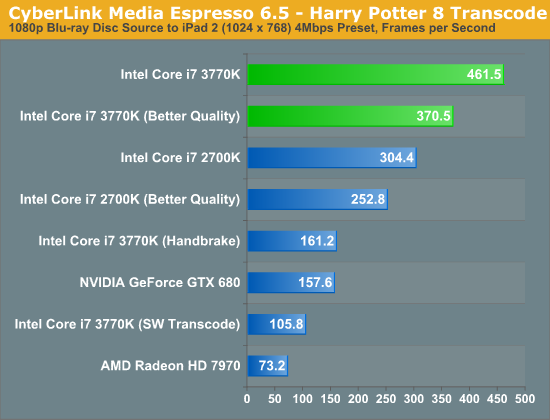
Just as we saw with Sandy Bridge, Quick Sync continues to be an incredible way to get video content onto devices other than your PC. One thing I wanted to make sure of was that Media Espresso wasn't somehow holding x86 performance back to make the GPU accelerated transcodes seem much better than they actually are. I asked our resident video expert, Ganesh, to clone Media Espresso's settings in a Handbrake profile. We took the profile and performed the same transcode, the result is listed above as the Core i7 3770K (Handbrake). You will notice that the Handbrake x86/x264 path is definitely faster than Cyberlink's software path, by over 50% to be exact. However even using Handbrake as a reference, Quick Sync transcodes over 2x faster.
In the tests below I took the same source and varied the output quality with some custom profiles. I targeted 1080p, 720p and 480p at decreasing average bitrates to illustrate the relationship between compression demands and performance:
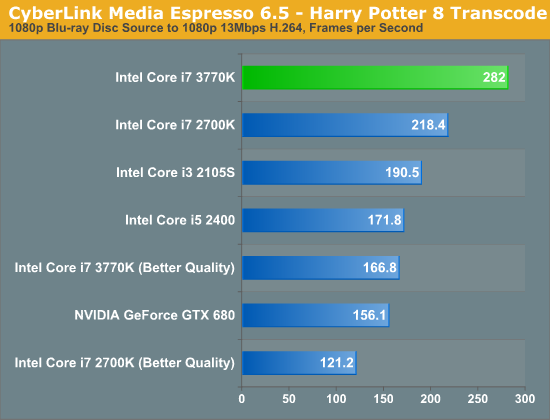
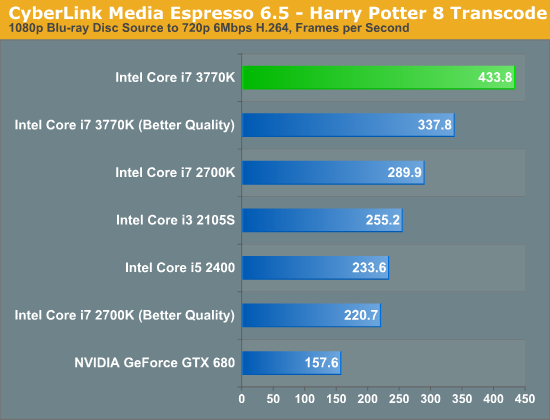

Unfortunately NVENC performance does not scale like Quick Sync. When asked to preserve a good amount of data, both NVENC and Quick Sync perform similarly in our 1080p/13Mbps test. However ask for more aggressive compression ratios for lower resolution/bitrate targets, and the Intel solution quickly distances itself from NVIDIA. One theory is that NVIDIA's entropy encode block could be the limiting factor here.
Ivy Bridge's improved Quick Sync appears to be aided both by an improved decoder and the HD 4000's faster/larger EU array. The graph below helps illustrate:
If we rely on software decoding but use Intel's hardware encode engine, Ivy Bridge is 18% faster than Sandy Bridge in this test (1080p 13Mbps output from BD source, same as above). If we turn on both hardware decode and encode, the advantage grows to 29%. More than half of the performance advantage in this case is due to the faster decode engine on Ivy Bridge.


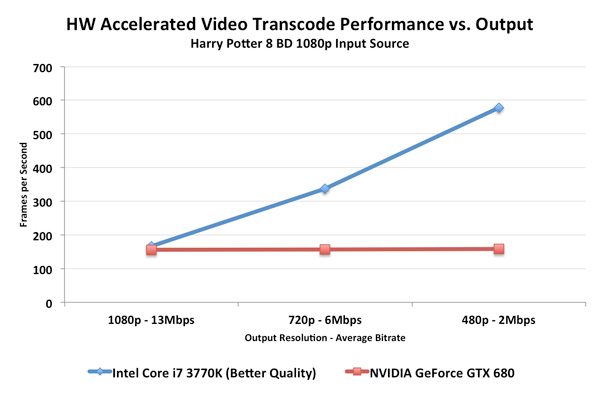
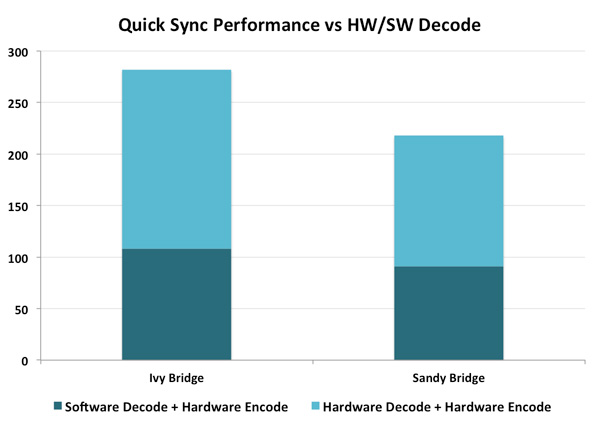








173 Comments
View All Comments
pwnsweet - Saturday, April 28, 2012 - link
nevermind, I'm an idiot. I found it.PG - Sunday, April 29, 2012 - link
http://ark.intel.com/products/65511/Intel-Core-i5-...ktmobi - Wednesday, May 2, 2012 - link
Keep in mind that in Ivy Bridge, CPU speed is directly propotional to GPU's speed + performance.Source - http://mobilityupdate.com/notebooks/intel-hd-4000-...
BSMonitor - Wednesday, May 2, 2012 - link
In the mobile line up, there is only 1 SKU for Intel Processors. As they cut back on the CPU, the HD3000 or HD4000 remains for ALL mobile GPUs.SalientKing - Tuesday, May 8, 2012 - link
I just got a 3450, the tag on it says 95w, your chart here says 77w. I'm a little worried i just got a repackaged SB cpu....warmbit - Wednesday, May 9, 2012 - link
For those who want to see a comparison of 3770K to 2600k in more games (several sites), please check the article:http://translate.google.com/translate?hl=pl&sl...
DaddyMacCadillac - Thursday, June 14, 2012 - link
"Quick Sync's transcoding abilities are limited to applications like Media Espresso or ArcSoft's Media Converter—there's still no support in open source applications like Handbrake."Umm, try MediaCoder, steep learning curve but it works great! I also wish Handbrake would adopt this technology...
midn8t - Thursday, June 28, 2012 - link
I would like to say that they do not seem to say what they are running for GPU, also I own the fx chip in this review and would like to say that with the 7970 driect cuII asua vide card, I get way over those FPS in dawn of war maxed out gfxs I am getting 134 average fpsI also own dragonage and when I am running fraps I am getting maxed res max AA getting 139 average fps
cyris I get 139 fps and I get civ 5 225 fps
be honest the cpu has little to do with FPS its video card mostly anyways I am running eyeinfity setup on top of this and getting these fps in game according to fraps
midn8t - Thursday, June 28, 2012 - link
I have the AMD FX 8150 and I also own Crysis: Warhead, Civilization V, Dawn of War II, and Dragon Age Origins and I get way better FPS then they claimed to have gotten I mean my FPS are almsot double that, sometimes tripple and I am using Farpsfor exampel Civ 5 I get average of 190 FPS in game maxed out res with eyeinfity using Fraps
but I am also using a 7970 Directcu2 GPU
galestorm - Thursday, June 28, 2012 - link
double post, I almost did same thing lol, becuase I noticed my post was tooken down or did not show up right away..I have to agree with you I own your CPU also, one they dont claim to be using on board GPU meaning one built into CPU and if they where far as I know teh AMD fx dosnt have a built in GPU so it would suck and there actully called APU i belive ?
anyway I was also wondering what GPU they where using for the test becuase when I read this page it dosnt say it any where and page before the two buttons say review back and review http://www.anandtech.com/show/5771/the-intel-ivy-b... dosnt say anything about what GPU there using, but I do own amd FX and I also own a 7970 GPU and I will say that the FPS ratting on here a AMD FX comboed with 7970 you will get ammzing FPS in game it blows these fps they claim out of the water, the FPS 50 FPS I mean I use to get that with my 5k series amd card I hell I use to get 45 to 50 fps with my 6k series eyeinfity card this 7970 gets like use above says double or tripple preformance of whats claimed in this review with fraps.